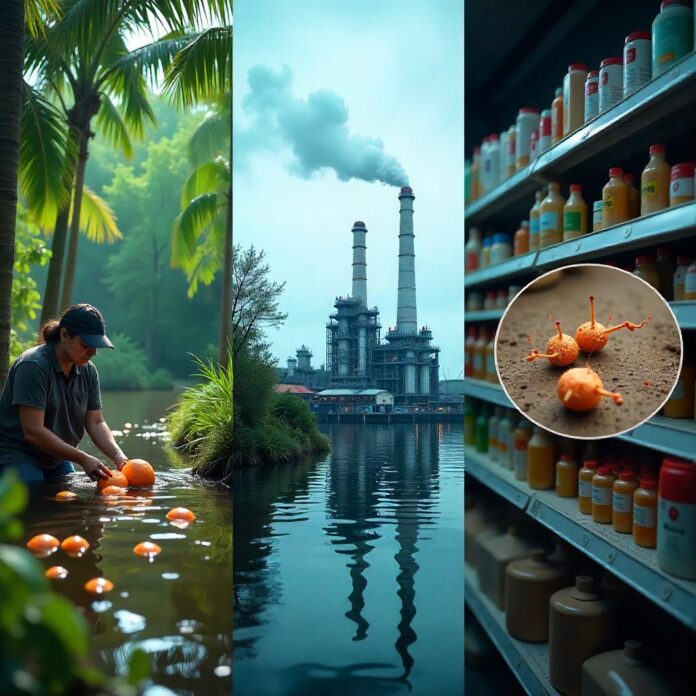The Invisible Threat in Our Pantry
Open your pantry. That chocolate spread? Those crackers? That microwave popcorn? Odds are they contain palm oil—an ingredient lurking in over 50% of supermarket products from infant formula to baked goods. While the environmental costs of palm oil have made headlines a more insidious danger remains hidden: toxic contamination that infiltrates our food from farm to fork. A food safety specialist who’s tracked edible oils for 15+ years witnessed how supply chain failures and regulatory gaps allow carcinogens and pathogens to invade everyday foods. This isn’t just about saturated fats; it’s about a broken system compromising global health. Let’s dissect the journey of a single palm oil droplet—and how it turns toxic.
Microbial Minefield – Pathogens in Raw Palm Oil
Farm-Level Contamination Vectors
The contamination crisis begins in the steamy palm plantations of Ghana Nigeria and Indonesia. Traditional fruit processing relies on pond water teeming with fecal coliforms introducing E. coli and Pseudomonas during sterilization. Fermentation—a crucial step to separate oil from pulp—often occurs in uncovered pits for 5–7 days allowing Staphylococcus aureus to proliferate to dangerous levels. Microbial loads vary 100-fold across regions: oils from Ghana’s Ashanti Region harbor significant coliforms while controlled facilities show negligible counts.
Dominant Pathogens Isolated
| Pathogen | Health Risk | Prevalence |
|---|---|---|
| S. aureus | Enterotoxin-induced vomiting, diarrhea | 68% |
| E. coli O157:H7 | Hemolytic uremic syndrome (kidney failure) | 42% |
| P. aeruginosa | Drug-resistant infections | 37% |
The Raw Consumption Hazard
In producing regions cultural practices amplify risks. Consuming unheated palm oil with cassava or as diarrhea remedies bypasses thermal kill-steps exposing consumers to bioactive enterotoxins. This is implicated in acute gastroenteritis cases in oil-producing communities. Unlike refined oils artisanal red palm oil—prized for its nutrients—retains these pathogens when heat treatment is skipped.
Processing Perils – When Refined Doesn’t Mean Safe
High-Temperature Toxicogenesis
Refining crude palm oil at 200°C—standard industry practice—creates chemical time bombs: Glycidyl esters form in palm oil at levels dramatically higher than other oils. These are confirmed genotoxic carcinogens that damage DNA. MCPD esters exceed tolerable daily intake limits by significant margins in infants. Biological studies confirm intestinal hydrolysis of these esters into free glycidol which damages organs at low doses.
Vulnerable Populations
Infants fed formula containing palm oil absorb glycidol at levels far exceeding safety thresholds. Regulatory agencies warn this group faces the highest risk due to immature detoxification systems formula dependency and cumulative exposure from multiple food sources.
Farm-to-Fork Failure Points
Production
Plantations apply significant pesticides per hectare which leach into fruit bunches alongside heavy metals. Deforestation through slash-and-burn clearing dramatically increases fungal colonization spiking cancer-causing toxin risks in smoke-exposed fruit.
Processing
Most production in developing regions comes from facilities lacking sterile bottling lines. Reused containers boost microbial loads significantly. Mid-scale processors skip essential deodorization steps to cut costs leaving contaminants at substantially higher levels than properly processed oils.
Distribution & Retail
Palm oil transported at elevated temperatures accelerates carcinogen formation. Banned adulterants still contaminate significant portions of exports masking low-grade oils carrying dangerous pathogens.
Consumer Handling
Most households double-dip utensils into raw palm oil after contact with raw meat cross-contaminating with additional pathogens. This common practice creates final-stage contamination vectors in home kitchens.
Evidence-Based Solutions
Pre-Harvest Interventions
Fermentation biocontrols using specific bacteria reduce pathogens within hours in field trials. Affordable manual screw presses eliminate water contamination while boosting yields for small producers.
Processing Overhauls
Innovative soft-refining protocols slash carcinogens while preserving nutrients. Real-time monitoring technology enables corrective actions during refining preventing significant batch losses.
Policy Levers
New contaminant caps establish mandatory limits though still higher than health-optimal levels. Enhanced certification standards require documented pathogen testing and contaminant tracking with growing industry adoption.
Consumer Empowerment
Understanding oil labeling helps identify higher-risk products. Alternative oils now perform similarly in food applications at lower costs thanks to recent agricultural improvements.
From Awareness to Action
Farm-to-fork palm oil contamination isn’t inevitable—it’s the result of profit-driven shortcuts and lagging regulations. While pathogens devastate producing regions refining byproducts threaten global consumers daily. Breaking this cycle demands industry transparency through public contaminant reporting equitable technology access for small producers and consumer vigilance in selecting certified sustainable options. Our collective health hinges on transforming this ubiquitous ingredient from a hazard vector into a model of food safety integrity. The solutions exist; now we need the will to implement them. Stay informed. Demand better. Your pantry is ground zero.


